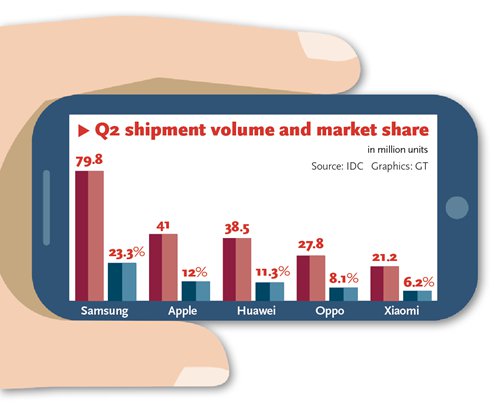
(Graphics/GT)
Telecommunication services provider Huawei Technologies Co is reportedly focusing toward the low-end smartphone market, a turnaround from its 2015 move to raise its profile at the upper segment of the market.
Experts said that it is Huawei's strategy to take market share from global rivals like Apple Inc and Samsung Electronics Co, and Huawei could potentially start expansion in the African, South Asian and Southeast Asian markets.
Huawei's founder Ren Zhengfei told a company meeting that he wants to see a focus toward the low-end smartphone market, the Securities Daily reported Wednesday.
"More than 90 percent of the world population is impoverished, and our competitors have explored markets for poor people, who should not be neglected," Ren was quoted as saying in the report.
Ren's remarks were made on July 6, which means that starting in the second half of this year, Huawei was already following the new strategy, according to the report.
"Ren has high standards, so 'low-end' does not mean low quality. It means cost-effective smartphones, aiming to fulfill the demand of consumers who live in poor areas in the world," Liu Dingding, an independent technology analyst, told the Global Times on Wednesday.
In recent years, domestic phone makers such as Lenovo and TCL have increased shipments by selling smartphones to markets in Africa and Latin America, Liu said, noting that "it is impossible that Huawei has not noticed the great growth potential in these markets."
Each model offered by these brands in emerging markets costs no more than 1,000 yuan ($151), and some only cost half that, Liu said.
An expanding presence in low-end markets will help domestic phone producers develop demand there and offer some Internet added-value services in the future, according to Liu. "It is a vital strategic deployment."
Wang Yanhui, head of the Shanghai-based industry organization Mobile China Alliance, agreed, saying that Huawei performed quite well in the European and U.S. markets, but less so in rising markets in Africa, South Asia and Southeast Asia.
"If Huawei only focuses on mid- and high-end markets while neglecting low-end ones, its growth will be limited," Wang told the Global Times Wednesday. He said that "high-end products could help Huawei build up its brand while the low-end markets could expand its total sales volume."
Wang said that Huawei is likely to increase its investment in the Southeast Asian and South Asian markets.
Competition is set to get even tougher if Huawei focuses on the low-end smartphone market, Liu said. Domestic rivals such as Xiaomi, ZTE, TCL and Lenovo that concentrate on the low- and mid-end markets will be worst-hit because Huawei has strong capabilities in manufacturing and research and development, plus a relatively high brand value.
If the aggressive Chinese smartphone maker really wants a larger global market share, it should move into the low-end market, just like its competitor Samsung, experts said.
It is relatively easy for Huawei to surpass global rivals like Apple and Samsung in terms of shipments, but it is still difficult for the Chinese company to match their influence, Liu said.
Samsung remained the leader in the global smartphone market with a 23.3 percent share in the second quarter, followed by Apple and Huawei with 12 percent and 11.3 percent, respectively, according to data released by industry research firm IDC in August.
Huawei achieved 19.6 percent year-on-year growth in the second quarter while Samsung and Apple made only mild gains of 1.4 percent and 1.5 percent, respectively, the IDC data showed.
Experts said that Huawei will not abandon the high-end market and it will keep trying to build its brand in that segment to compete with global rivals.
Huawei started raising its profile at the upper end of the market in 2015, when it released an array of premium smartphones, including the Mate and Ascend P models.
On October 16, Huawei launched its latest smartphone in Germany, with the flagship product kicking off the new era of intelligent phones that use artificial intelligence.


















































